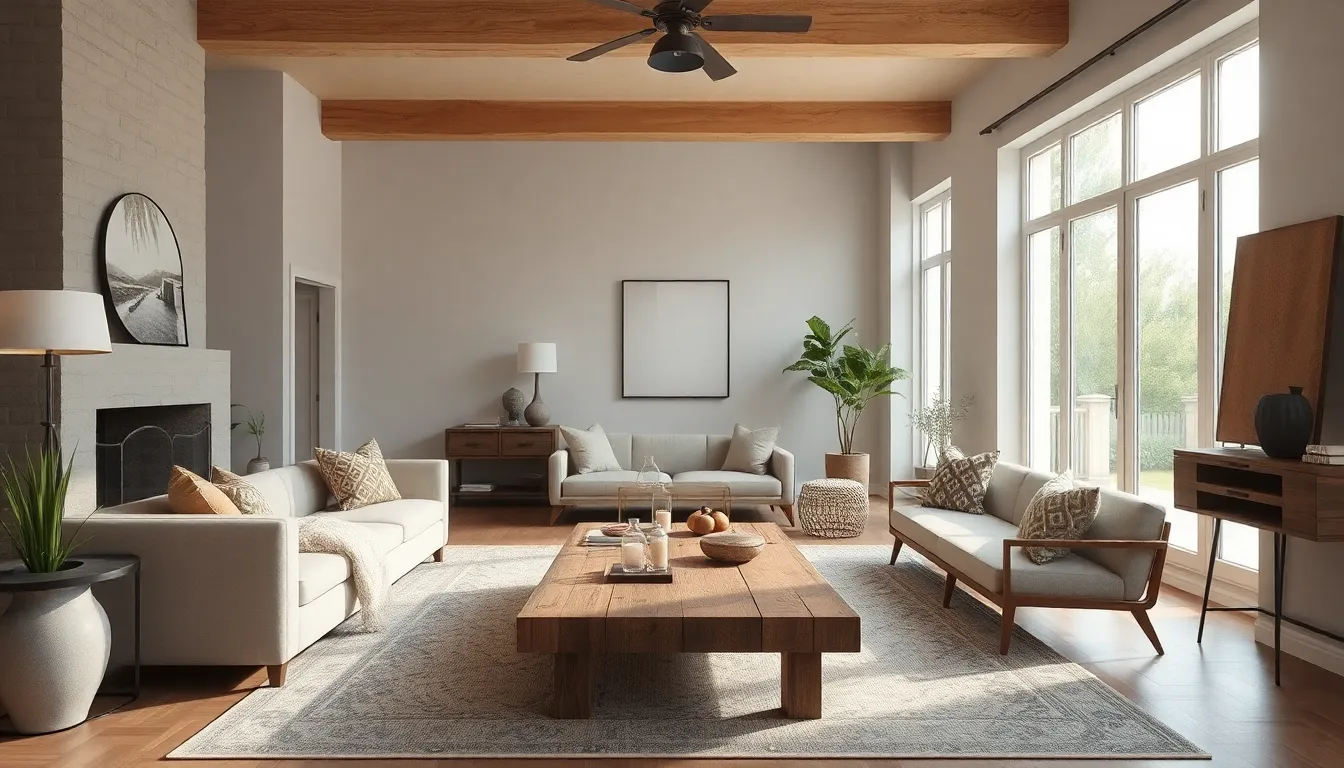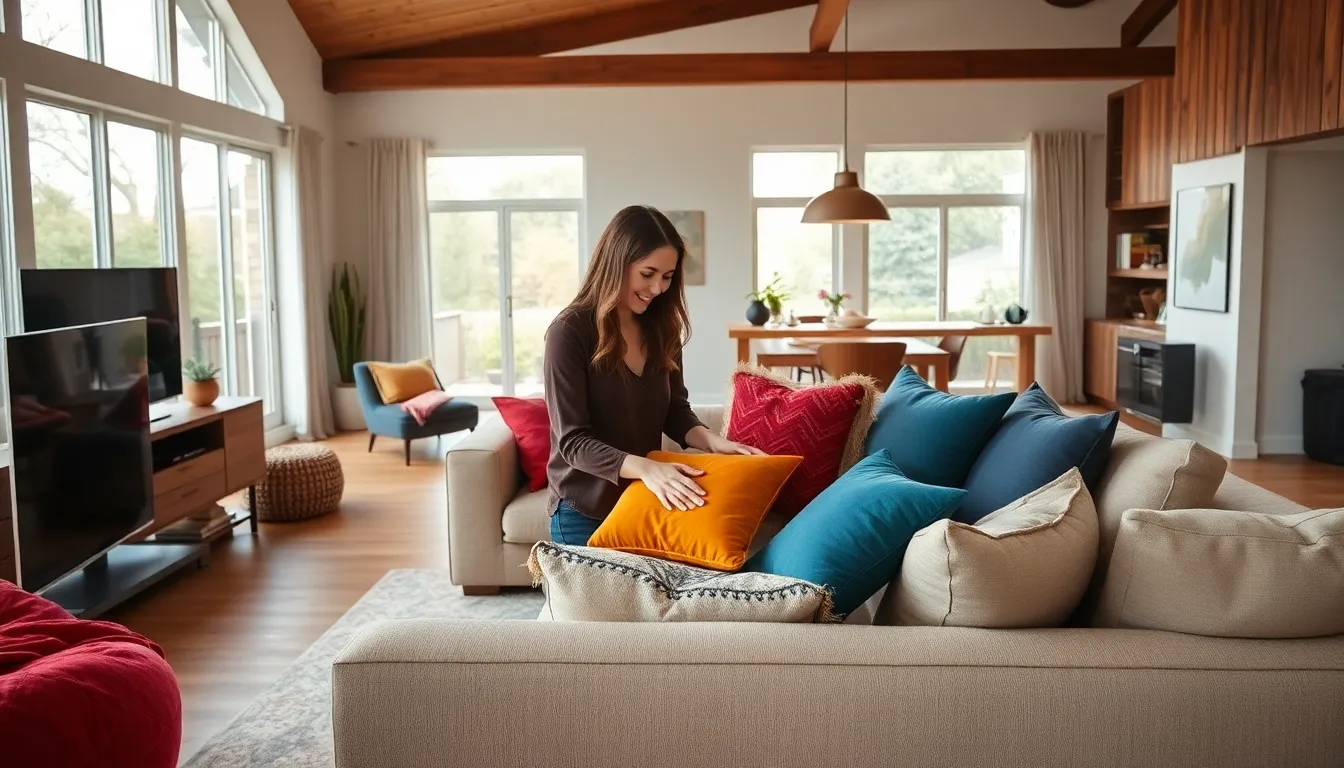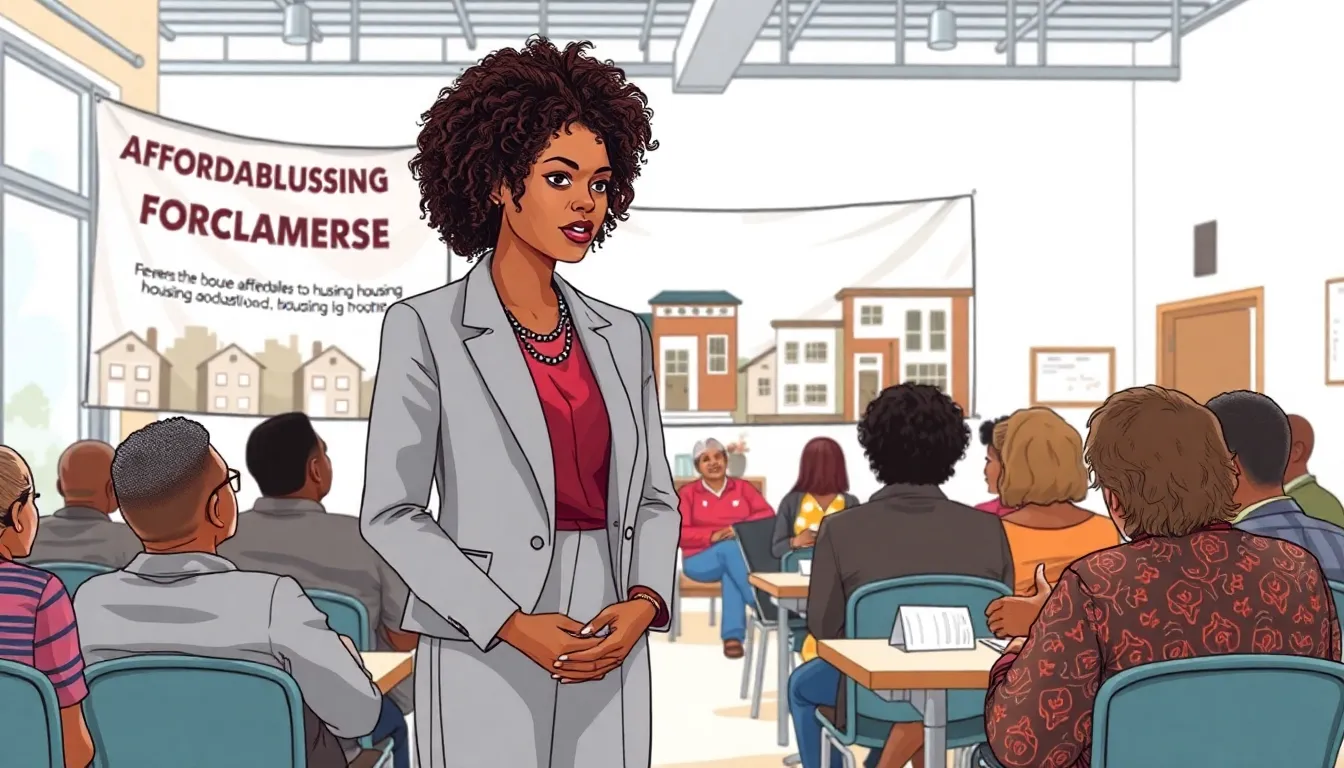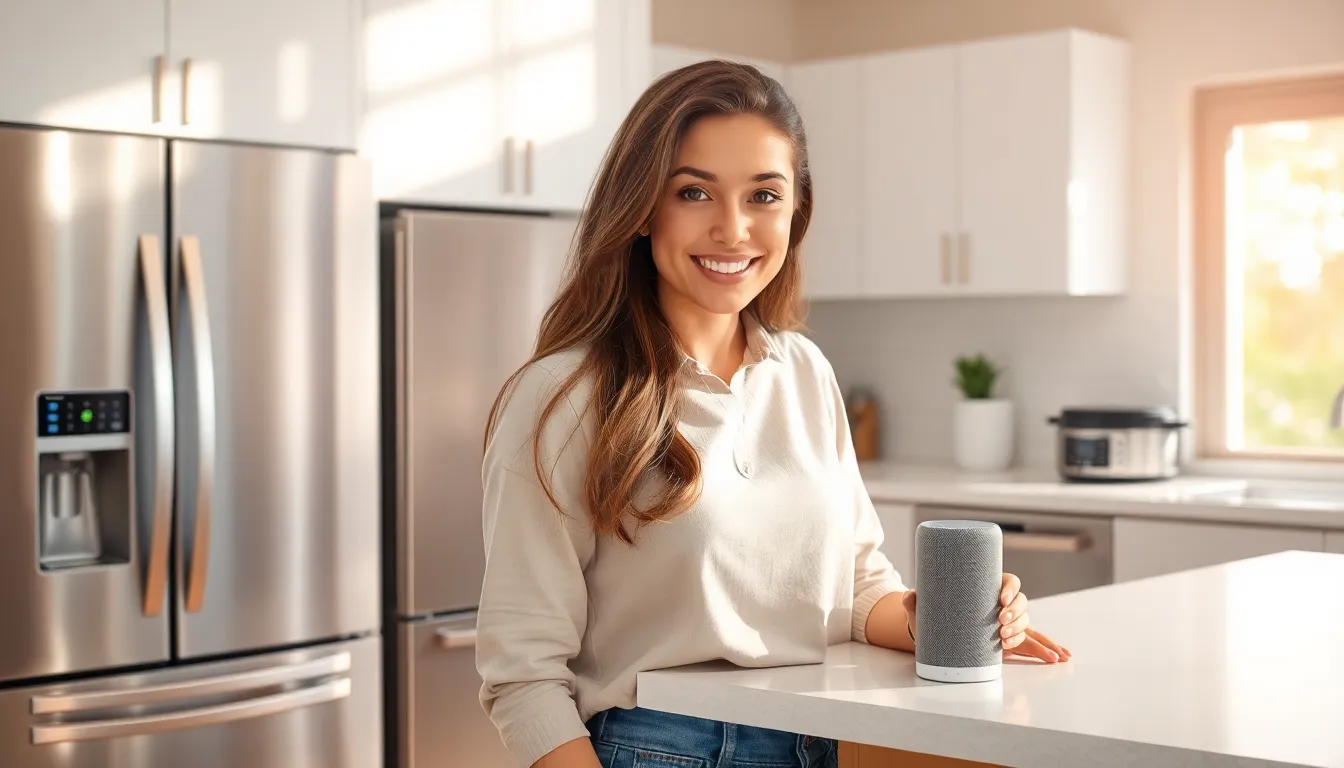Home design trends are like fashion for your living space—what’s in today might be out tomorrow, but the right choices can make any home a runway. As styles evolve, homeowners are left wondering how to keep their spaces fresh and inviting without breaking the bank or their sanity. Whether it’s embracing bold colors or opting for minimalist chic, the right design can transform a house into a home that reflects personality and taste.
Table of Contents
ToggleOverview of Home Design Trends
Home design trends reflect shifts in lifestyle, preferences, and cultural influences. Significant changes arise in color palettes, materials, and furniture styles. Sustainable materials gain popularity as homeowners seek eco-friendly options. Bold colors emerge as a way for individuals to express their personalities, while neutral tones often provide a calming backdrop.
Open floor plans remain favored, promoting a sense of space and connectivity. Multi-functional furniture has gained traction, catering to modern living demands. Flexibility in design supports diverse needs, particularly in smaller homes. Textures also play a critical role; mixing soft fabrics with hard surfaces introduces visual interest.
Smart home technology increasingly integrates into design, enhancing convenience. Homeowners incorporate smart lighting and temperature control systems for energy efficiency. Outdoor spaces see a revival, with landscaping designed for relaxation and entertainment. The focus shifts to creating serene environments that blend indoor and outdoor living.
Minimalist approaches emphasize simplicity and function. Clutter-free spaces contribute to overall well-being. Vintage influences rise as individuals incorporate unique pieces that tell a story. Eclectic styles encourage blending various design elements for a personalized touch.
Such trends reflect a deeper understanding of individual lifestyle needs and aesthetic desires. Staying attuned to these changes facilitates thoughtful design choices tailored to evolving preferences. Home design continues to innovate, promoting creativity while addressing practical aspects of living.
Popular Home Design Styles

Home design encompasses various styles that reflect personal preferences and current trends. Each style offers unique characteristics and appeals to different tastes.
Contemporary
Contemporary design emphasizes clean lines and a neutral color palette, creating a sleek and sophisticated look. This style incorporates natural light through large windows, enhancing the overall ambiance. Often, it features a mix of textures, such as wood, metal, and glass, to add depth. Furniture in contemporary spaces tends to focus on functionality, with open spaces allowing for easy movement. Additionally, it embraces eco-friendly materials, aligning with sustainable living practices that many homeowners value today.
Rustic
Rustic design draws inspiration from nature, showcasing organic materials like wood and stone. This style often promotes warmth and coziness, creating inviting spaces that feel like a retreat. Vintage accents, such as reclaimed wood furniture, add character and charm. Earthy color palettes, featuring browns, greens, and warm neutrals, enhance the connection to the outdoors. Natural fibers in textiles, like linen and cotton, complement rustic elements and create a comfortable atmosphere.
Minimalist
Minimalist design focuses on simplicity and functionality, eliminating excess for a clean aesthetic. Neutral colors dominate this style, supporting a calm and spacious feel. Simple shapes and unobtrusive furnishings allow for flexibility while maintaining elegance. This design often includes multifunctional furniture catering to smaller living spaces. Decorative elements remain sparse, emphasizing organization and clarity. Overall, minimalism encourages a serene lifestyle, promoting well-being through uncluttered environments.
Color Palettes in Home Design
Color palettes play a crucial role in defining the atmosphere and aesthetic of any home. Designers in 2023 favor colors that blend boldness with subtlety, catering to diverse tastes and preferences.
Trending Colors for 2023
Earthy tones dominate this year’s trends. Terracotta, sage green, and deep blue offer warmth and tranquility. Pastel shades reemerge, bringing soft hues like blush pink and light lavender into spaces. Those colors evoke calmness and comfort, ideal for personal retreats. Additionally, vibrant accents, including mustard yellow and vibrant coral, provide pops of energy against muted backdrops, allowing for individual expression. The mix of these hues creates a balanced environment conducive to both relaxation and creativity.
Neutrals vs. Bold Colors
Neutral colors remain timeless choices, promoting serenity and spaciousness within homes. Whites, grays, and beiges serve as perfect base colors for various design styles. Many homeowners incorporate neutral tones to set an inviting stage for furnishings and decor. Bold colors, on the other hand, express personality with striking contrasts. Adding splashes of jewel tones or daring shades in accent walls or decor pieces energizes a space, making it unique. Combining both approaches allows homeowners to curate environments that reflect personal style while maintaining visual harmony.
Sustainable Design Practices
Sustainable design practices prioritize environmental responsibility and resource efficiency in home design. These methods significantly contribute to creating healthier living spaces.
Eco-Friendly Materials
Sustainable materials play a vital role in modern home design. Bamboo, reclaimed wood, and recycled metal are popular choices that reduce waste. Using non-toxic paints and finishes minimizes indoor air pollution, improving household health. Homeowners are increasingly opting for energy-efficient appliances made from sustainable materials, promoting both performance and eco-friendliness. Adding natural textiles like organic cotton or linen enhances comfort and sustainability. Incorporating these materials fosters a connection to nature, encouraging mindful consumption while enhancing aesthetic appeal.
Energy Efficiency in Home Design
Energy efficiency stands as a cornerstone of sustainable home design. Implementing LED lighting and energy-efficient windows cuts utility costs while reducing environmental impact. Smart home technology enables better energy management, allowing for monitoring and control of consumption patterns. Proper insulation plays a crucial role in minimizing energy loss, contributing to a comfortable indoor climate. Solar panels present a renewable energy solution, decreasing reliance on nonrenewable resources. Homeowners benefit from tax incentives and long-term savings when focusing on energy-efficient features, making sustainability a practical choice.
Smart Home Technology Integration
Smart home technology significantly enhances convenience and energy efficiency in modern designs. Homeowners increasingly integrate these innovations into their living spaces to boost security and improve everyday life.
Automation and Security
Automation transforms homes into smart environments that respond to user preferences. Smart devices like video doorbells and security cameras provide enhanced protection. Many systems allow for remote monitoring, enabling quick responses to potential threats. In addition, automated lighting and climate controls create comfort tailored to individual lifestyles. Sensors detect movement and environmental changes, alerting homeowners in real time. Integration of these features ensures peace of mind, promoting a safer living experience.
Innovative Gadgets for Homeowners
Innovative gadgets simplify daily tasks while adding a touch of modernity to homes. Smart speakers act as personal assistants, controlling music, appliances, and schedules. Homeowners can manage tasks hands-free using voice commands. Smart thermostats adjust heating and cooling based on preferences, reducing energy consumption. Smart kitchens now feature appliances that connect to the internet, streamlining meal preparation. Additionally, robotic vacuums automate cleaning, giving homeowners more free time. Adoption of these technologies not only enhances everyday life but also signifies a shift towards more connected, efficient home environments.
Home design trends are a reflection of personal style and evolving lifestyles. By embracing bold colors sustainable materials and innovative technology homeowners can create spaces that are not only visually appealing but also functional and eco-friendly. The blend of contemporary rustic and minimalist styles offers endless possibilities for expression while catering to the demands of modern living.
As trends continue to shift it’s essential for homeowners to stay informed and make choices that resonate with their individual tastes. Whether revamping outdoor spaces or integrating smart home features the goal remains the same: to craft a home that feels uniquely theirs. With thoughtful design decisions it’s possible to achieve a harmonious balance between aesthetics and practicality.








